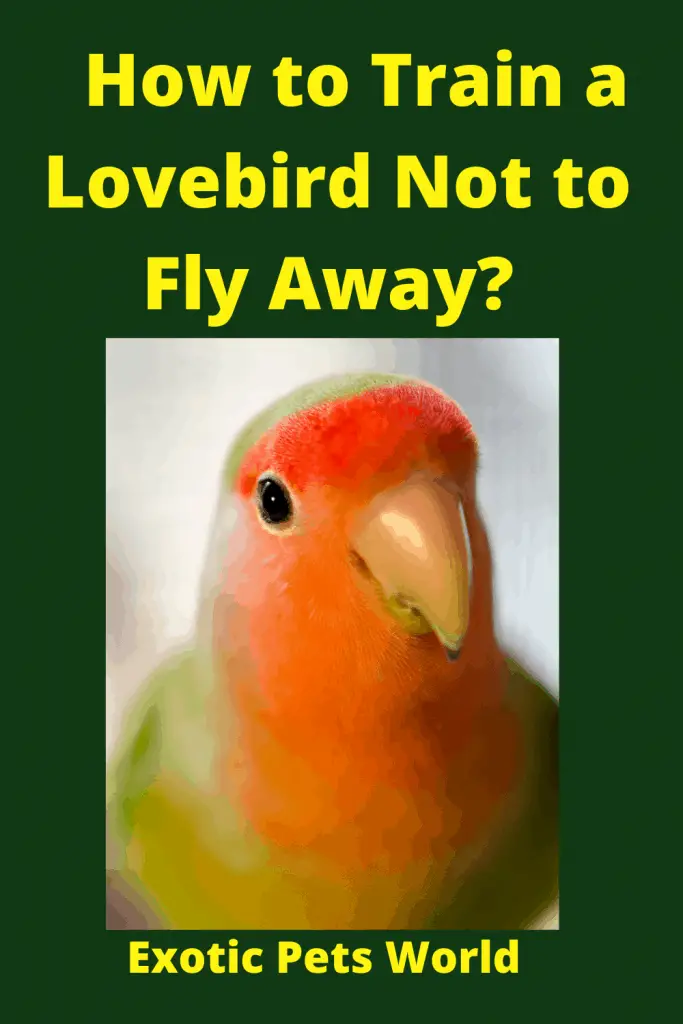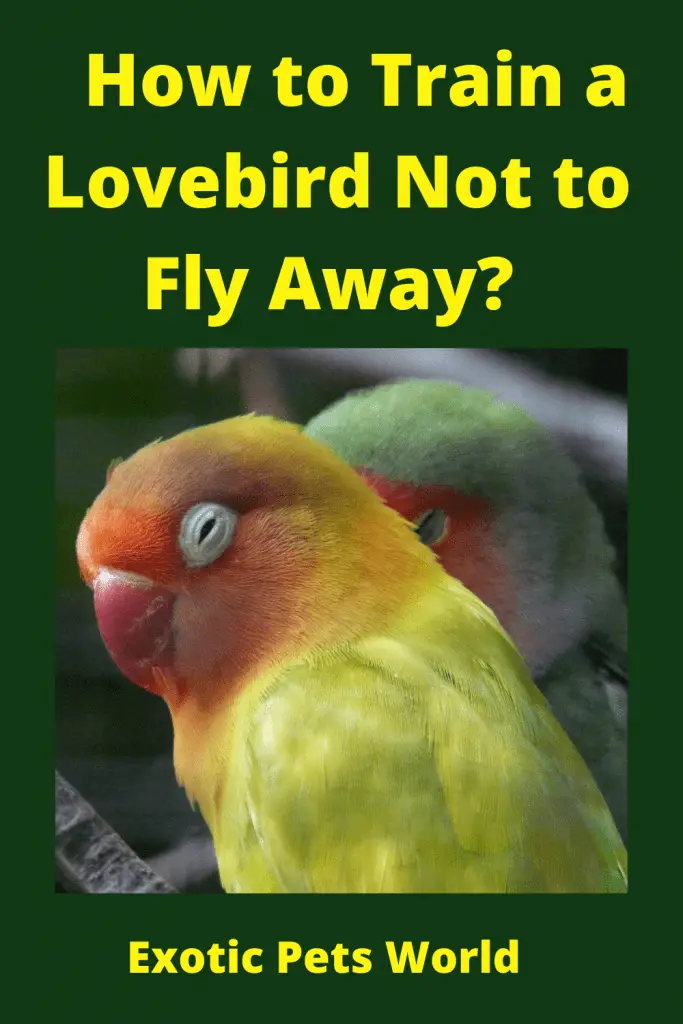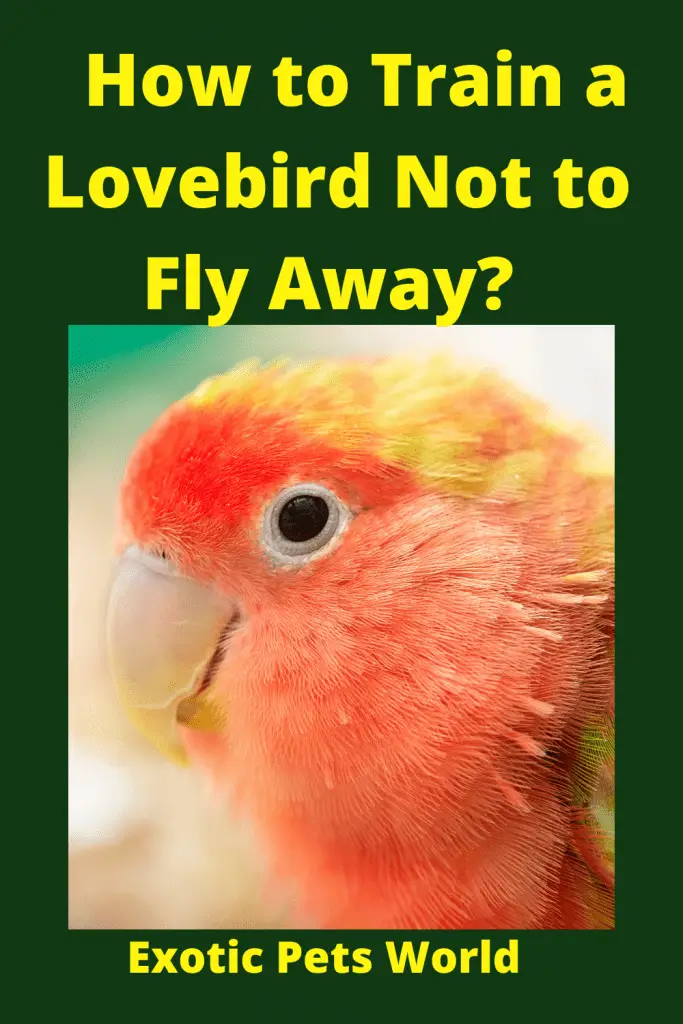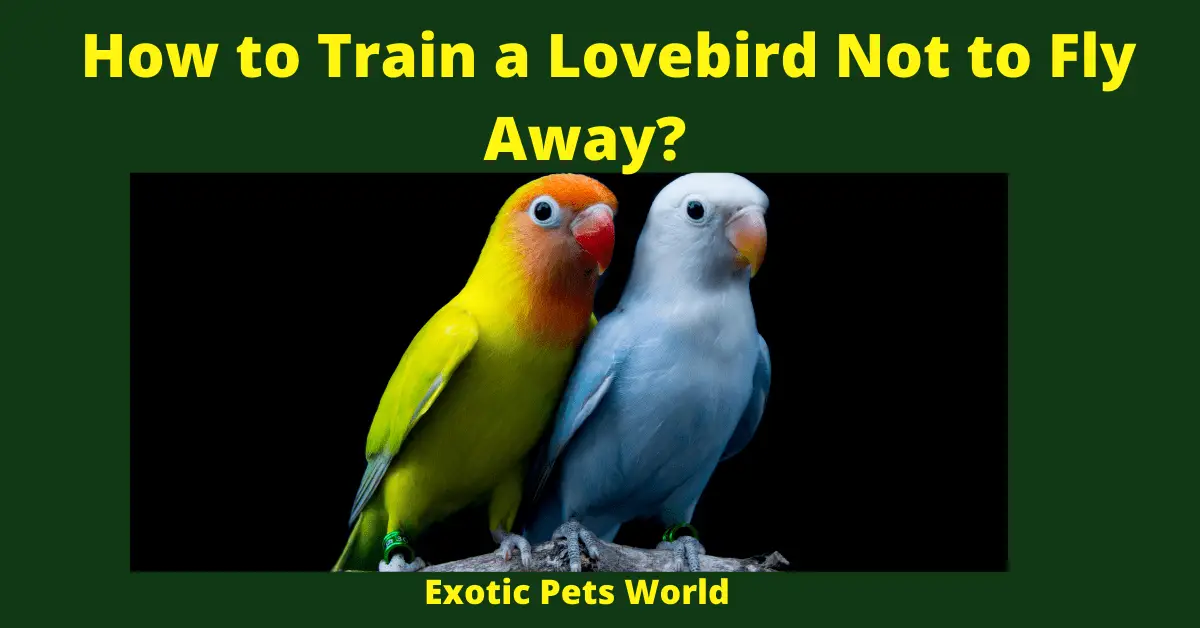Important Tips to train your Lovebird not to fly away.
- Bird Harness
- Begin Training Inside
- Positive Rewards – Treats
- Clip One wing – if all else fails
How to Train a Lovebird Not to Fly Away?
How to Train a Lovebird Not to Fly Away? Lovebirds are one of the most common pet parrots species, and it’s no surprise for those acquainted with them. Adorable and wise, these little birds have been one of the most beloved forms of African parrots for over 100 years. Nevertheless, there are numerous misconceptions about lovebirds, their behavior, and what it’s like to hold them as creatures.
While they are a kind of parrot. Lovebirds are not among the animals you would deem communicating birds, and they can imitate the human voice.
This is because they decide to talk occasionally; even whenever they want to replicate a tone, they echo simple noises such as whistles or household sounds such as doorbells and microwaves more frequently than not. It is not clear that certain lovebirds are more inclined than others to imitate the voice, but it is generally accepted that many who learn to speak are trained from a very early age.
Although they are real parrots, lovebirds are one of the parrot family’s smallest members. On average, when calculated from the beak to the end of the tailfeathers, most lovebirds drop between 5 and 7 inches long at maturity. Their compact scale has served to improve their reputation with those residing in small spaces and apartments.
Instead of seeking to hold a giant parrot breed, such as a macaw or a cockatoo, many of these bird enthusiasts have found it simpler to house and care for these little birds.

Can You Train a Bird Not to Fly Away?
It’s an essential part of the training of birds and should be done immediately. You don’t want to develop a situation where the bird finds an opening and leaves the birdcage, never to return!
Unfortunately, far more than bird owners might want to accept, this occurs, which is why being proactive is safest. You can rein them in and make sure they don’t know how to return by learning how to train a bird not to fly away.
The advantages of training include:
- Safer Training Sessions
- Easier to Promote Free-Flying Sessions
- Improves BIrd’s Health
Don’t believe that if it gets out, the bird will return. This is a widespread misunderstanding regarding the owner of the bird. A bird will find a way to break out of a bird’s cage and then travel far away from you.
If there’s no training in place, it’s normal and what they will look to do. This comprehensive guide would illustrate how a bird can be taught not to fly away, what to use, and how to ensure that healthy habits are established.
How Do you Keep a Pet Bird From Flying Away?
Use a Bird Harness
It’s essential to worry about utilizing a quality bird harness when you learn how to train a bird not to run away. These are proven to produce outstanding outcomes and stay resilient in all circumstances. It is recommended to start with short sessions to get the hang of things if you are worried about using a bird harness for training a bird.
Mastering the art of using a bird harness can take a bit of time, but ultimately it will produce excellent results. It’s nice to use a bird brace for training birds because it gives you the ability to optimize their training sessions.
Remember, be sure to let the bird decide stuff for a while as you are doing this. This will have power and mobility for them while they travel about. This is crucial because they’ll feel constrained, and it can take away from a training session.
The bird harness needs to be used wisely if you choose to understand how to train a bird not to run away. When the bird seems to run away from you, don’t pull on it and “control” it. After a bit, during flying sessions, the bird can get used to you being there, which is when the findings will arrive!
Start Indoors
When are you going to do the bird training? Heading outside does not make sense in the first training session. This will offer the bird much too much independence, and in seconds, you’ll lose all semblance of power! Be vigilant to make sure they are only approved indoors for a flying session.
This may be a simple space where the birdcage is housed within your home. You want to make sure the concept of traveling and then returning is used to them. You are not going to work out how to train a bird to fly away without doing this. They’re trying to take advantage of the stuff, and that isn’t very good.
The aim should remain to rely on what works, and that is a training session indoors. Indoor sessions are lovely, and you can get them inside a controlled room in your house even though the bird doesn’t listen. Rather than trying to run them around outside, this is far better to deal with! When you understand how to train a bird not to run away, this is important.
Give Them Bird Treats
When you’re around, what about showing the birds something to look forward to? It is heralded that bird rewards are a perfect way to pamper the bird and make them want to linger. Otherwise, they would decide to travel in the opposite direction as soon as you see them go. To stop this, during initial training sessions and also while you are cuddling with them, use bird treats. This will make a closer relationship, and you’re going to find the bird able to be with you more.
The advantages include:
- An Incentive for the Bird to Stay
- Triggers a Positive Response
- Great for Bird’s Mental Wellbeing
Be sure that they are healthy for the bird to consume while using bird treats to train a bird. You ought to use treats that in the future would be sustainable and won’t hamper the wellbeing of the bird.
And anything as easy is going to get the job done as bird seeds. When you learn how to train a bird not to run away, some reward goes a long way. It might seem hard at first, but bird treats can prevent them from moving in the opposite direction. For someone passionate about what they are doing, this is a must. Look and have the bird pampered, and then get them to listen to you. The odds of accomplishment would go through the roof.

Start with Short Sessions
How long do your bird training sessions last? Because the bird can wear out, there is nothing worse than long flight hours. They will lose focus and will not listen as much until they start to wear out. You never want a scenario where a bird is conditioned to keep going until it can’t do it physically.
If so, you are training them to travel away from you in essence! Instead, you want to rely on brief training sessions with the bird for 15 to 20 minutes. Of course, you can start to realize what works and what doesn’t when you learn how to train a bird not to run away.
This ensures that you adjust and raise or decrease the training sessions depending on what is better for the bird. If not, you will know that the long hours will draw away from what is going on. When you are training a bird, be smart. You want to control their time, learn what fits with their body, and finally, during the brief session, hold them as close as possible. You are likely to see positive benefits by doing this.
Get Them Used to Your Touch
You’re going to have to create a strong relationship with your bird because it’s not going to run free. Generally speaking, it is advised to take a few months to operate with your bird. This involves investing in your hands or around you at least 30-60 minutes a day with them. It is one of the most straightforward approaches to create a deeper friendship. And when they’re flying openly, it gets simpler to hold them around when the bird sees you as a flock mate. Why does it matter for a bird to get accustomed to the touch?
The explanations include:
- Creates a Stronger Bond with the Bird
- Makes the Bird Want to Stay
- Leads to Controlled Behavior from the Bird
When a bird isn’t used to the touch, as soon as they get a bit of independence, they may not be able to stick around.
With treats, cats, and simply making sure they are comfortable, you have to shower them. This is the best way to guarantee that you are satisfied with what is happening. Otherwise, they would not be relaxed with the mechanism. When you learn how to train a bird not to fly away, always ensure that they are placed next to you during flying sessions. You want to drill home the point that your existence is contingent upon them.

Do Lovebirds Come Back If They Fly Away?
The response to this query is yes. If they go abroad, lovebirds come back. This is attributed to their innate companionship requirements. They are social creatures, and so their days revolve around their flock, an unofficial part of which you are. So, your parrot would want to come back home as it flies away. It would help if you even attempted to get the bird with a little bribery to go back home.
This will, though, only function if the parrot is on a tree outside. It is also possible that your parrot will fly a long distance, which will make it challenging for it to find a way back home, being both aerodynamic and strong fliers.
How Do you Train a Bird to Fly Outside?
Not all parrots have the skill set necessary for a free flight to navigate successfully. Although the above flight commands are a start, several other considerations must be addressed before enabling your bird to experience free flight.
The following critical stage is operating conditioning, which implies that further knowledge of how they can behave in the future is imparted from each contact we have with the parrot. A vital component of this kind of training is teaching different behaviors with positive reinforcement rather than punishment or restarting.
Your bird needs to understand that it is not instantly stuffed into its cage when it returns to you after a flight but rather rewarded with treats and kind words.
It is essential to learn your bird’s body language if you wish to flight your parrot free of charge. Your bird needs to be comfortable outside, and you should not attempt a flight if it seems to be nervous out, even if it has flown outdoors previously.
You also need to observe the weather and only let your bird fly in optimal conditions without strong winds or storms in the area.
In a home or a factory, training your bird to return to you from high positions will be mastered and requires to be incorporated in your parrot before you take it out to travel. One of the essential facets of preparing your bird for free flight is recall training. Below is the free-flying footage of healthy parrots.
Dangers of Free Flight for Your Parrots
There are many dangers that your parrot will not be exposed to in any other situations inherent in free flight. Here are some of the problems your parrot may face when flying freely.
- Your parrot can be chased and killed by a predatory bird.
- Your bird can get scared by something and fly out of sight.
- Sudden weather changes can force the bird to stay in a tree overnight.
- Your parrot wants to mate with another parrot and flies off to build the nest.
- You are flying your parrot in a new location, and it flies off and gets lost.
How to Train a Lovebird Not to Bite?
Some lovebirds have nasty habits; follow these necessary steps to stop a biting lovebird if you want to learn how to train a lovebird not to bite. On your part, it will take hard work, patience, and persistence, but birds are very clever, and a lovebird can learn with some extra love from you to stop this troubling behavior.
Build Trust:
For several reasons, a lovebird may be biting, but one of the more common reasons is that they don’t trust you. The first thing you have to do is build confidence between you and your bird to get your lovebird to stop biting. Your bird will begin to realize that they need not be afraid of you when you work on your relationship with your bird calmly and consistently.
Not only will having the ability to interact with your bird with physical contact make your bird happy, but it is also bound to make you happy; after all, it is not fun to own a pet you fear!
Have Patience:
Every bird is different, even though it may get stressful, and you do not know how long it would take to gain morale to get your bird to quit biting; it is essential to stay calm and to have patience. Work a bit every day with your bird, making sure you don’t do something that makes your bird feel threatened; this would slow down the process. You have to be cool and be careful and know that the bird will come around if you stay at it and never give up.
Start Small:
One quick way to begin to train your bird not to bite is to teach them the “touch” order. It would help if you used a pencil to start with and make your bird touch the eraser with its beak. Say the term “touch,” and when your bird complies, reward them with their preferred treatment in a way you are pleased with (an excellent gentle touch, rather than a bite of the eraser). Stick with this training before you can start using a pencil instead of your finger.
Cage Requirements for Love Birds
Lovebirds are playful, energetic parrots who require a wide cage to hold all the games and perches they need to keep them occupied. The bigger the cage, the more the bird would be happy with it.
The minimum cage size for a single lovebird could be 18″ long by 18″ wide by 18″ tall. For a pair of lovebirds, a cage 24″ long by 18″ wide by 24″ tall or wider will be more fitting.
A decent cage should have horizontal bars on at least two sides, as hookbills love to ascend. To make climbing simpler, horizontal bars aid. “To prevent injury, bar spacing should be no more than 3/4” apart.
It is possible to hold most birds at room temperature. Make careful to put the bird and its cage off the floor and away from drafty areas or hot locations such as open windows, air vents, and doorways. If exposed to a draft when they are damp (after a bath), certain birds can catch a cold, so it is better to maintain a wet bird in a heated environment (at least 70 degrees) until they are dehydrated.
For the feet to remain stable and solid, your lovebird cage can have at least two or three perches of varying sizes, shapes, and textures. Ensure the perches are thick enough for the bird to stand on them without losing its equilibrium safely. The shortest nest to be offered to a lovebird is 1/2″ in diameter. Choose nests constructed from several items such as wooden dowels, branches of natural wood, bonded sand/concrete (trimmed to hold their nails), and string.

If your bird is in a dark space, you may want to keep your bird’s cage hidden to help it sleep at night. If your bird lives in a more functional space, even low-volume noises will keep it awake, and it will not get the proper rest it requires to stay safe. Any night, lovebirds can have about 10-12 hours of uninterrupted sleep. You will want to find a smaller cage for your bird to sleep in and put it in a safer space if it’s not feasible to keep their room quiet for this length of time. Using a sleeping cage would give your bird a safe, peaceful place to sleep for a good night.
Health Problems for Love Birds
Birds of passion come with ailments, too. You need to understand that love birds have severe health concerns that might worry you and need to be considered. Here are a few health issues usually faced by love birds.
Psittacine Beak & Feather Disease
This is an extensive viral disease that affects birds of love and significantly spoils their wellbeing. It is widespread with lovebirds. In addition to lovebirds, illness is often usually present in African Greys. If they are too young or held in the same position as other birds, you will notice this disease threatens the lovebirds.
This viral infection will cause lovebirds to see irregular feather growth. In this case, the development of the beak is also hampered. You will see that the feathers become blunt in birds that have contracted this disease, while it leads to shaft bleeding in some cases.
Pacheco’s Disease
Another infectious disorder that is contained in lovebirds is this one. For birds, this may prove to be deadly. Necropsy procedures are used to detect this condition. This condition also attacks these birds’ liver and may even lead the birds of love to die. It is triggered by the involvement of the herpes virus in the lovebirds’ bodies. The only means to guarantee that the lovebirds are adequately handled and do not suffer fatal consequences are extensive supportive treatment.
Feather Plucking and Mutilation
The diet given to the lovebirds is very crucial. If insufficient food is offered to the lovebirds, you can find that they appear to get quite edgy. Because of this edgy behavior caused by them, they tend to get bored, and it might lead them to pluck their feathers. You may need to wash them periodically; else, plucking could also imply that they are attempting to clean themselves. An unsafe atmosphere contributes to situations like this.
Several lovebirds are suffering from what is generally referred to as a depression. Oh, it’s not surprising to see sad birds. Many of these stressed birds appear to lose weight when they continue to exhibit symptoms of distress. When you go to their cage to wipe their stools, you can encounter undigested food bits. When you see them displaying symptoms like that, you possibly realize it’s time to send them to the Avian Vet to have them screened.
Final Thoughts
When its wings are clipped, training your lovebird will be easier. Clipped wings will help prevent flying away from your bird. An avian doctor is willing to trim the wings of your bird for you. It should be relatively easy to teach your bird the ‘step up’ and ‘step down’ commands since these are actions your bird does naturally.
When stepping up, some birds may use their beaks for balance. Do not jerk your hand away if your bird puts its beak on your hand to step up. Jerking your hand away could keep him from standing on your hand.
Not all birds are going to chat. Male budgets, for instance, are more likely to speak than female budgets. Cockatiels are often less prone to be interacting than budgets. Please get to know precisely what the favorite food for your bird is so that you can use it for training.

can you drink alcohol with delta 8
There is definately a lot to find out about this subject. I like all the points you made